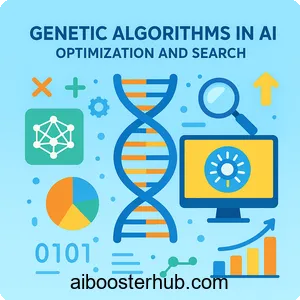Genetic Algorithms in AI: Optimization and Search
Genetic algorithms represent one of the most fascinating intersections between natural evolution and artificial intelligence. Inspired by Charles Darwin’s theory of natural selection, these powerful optimization techniques have revolutionized how we approach complex problem-solving in machine learning and computational intelligence. Whether you’re optimizing neural network architectures, solving scheduling problems, or discovering optimal trading strategies, genetic algorithms offer a robust framework for navigating vast search spaces where traditional methods fall short.

Content
Toggle1. Understanding genetic algorithms: Evolution meets computation
What is a genetic algorithm?
A genetic algorithm is an evolutionary algorithm that mimics the process of natural selection to solve optimization and search problems. At its core, a genetic algorithm in AI operates on a population of candidate solutions, iteratively improving them through operations inspired by biological evolution: selection, crossover, and mutation.
The fundamental premise is elegant: just as nature evolves organisms to be better adapted to their environment, genetic algorithms evolve solutions to be better suited to solving a specific problem. Each candidate solution is encoded as a “chromosome” (typically a string of bits, numbers, or other data structures), and the algorithm evaluates how well each chromosome solves the problem using a fitness function.
Why genetic algorithms matter in AI
Traditional optimization methods like gradient descent work exceptionally well for smooth, continuous problems where derivatives can be computed. However, many real-world problems in AI involve:
- Discrete search spaces where gradients don’t exist
- Non-differentiable functions that can’t be optimized using calculus-based methods
- Multimodal landscapes with many local optima that trap hill-climbing algorithms
- Combinatorial explosions where exhaustive search is computationally infeasible
Genetic algorithms excel in these scenarios because they maintain a diverse population of solutions and use probabilistic transitions rather than deterministic rules. This allows them to explore multiple regions of the search space simultaneously and escape local optima.
Key components of genetic algorithms
Every genetic algorithm shares several fundamental components:
Population: A collection of candidate solutions maintained throughout the algorithm’s execution. Population diversity is crucial for effective exploration.
Fitness function: A measure of how well each solution solves the problem. This function guides the evolutionary process by determining which solutions are more likely to reproduce.
Selection: The process of choosing parent solutions for reproduction based on their fitness. Common methods include tournament selection, roulette wheel selection, and rank-based selection.
Crossover: A genetic operator that combines genetic material from two parent solutions to create offspring. This operation exploits existing good solutions by mixing their characteristics.
Mutation: A genetic operator that introduces random changes to solutions, maintaining population diversity and enabling exploration of new regions in the search space.
2. The genetic algorithm workflow
Step-by-step process
The standard genetic algorithm follows an iterative process that mirrors natural evolution:
- Initialize a random population of candidate solutions
- Evaluate the fitness of each individual in the population
- Select parents based on their fitness values
- Apply crossover to create offspring from selected parents
- Apply mutation to introduce random variations
- Replace the old population with the new generation
- Repeat steps 2-6 until a termination condition is met
Let’s implement a basic genetic algorithm in Python to optimize a simple function:
import numpy as np
import random
class GeneticAlgorithm:
def __init__(self, population_size, chromosome_length, mutation_rate=0.01):
self.population_size = population_size
self.chromosome_length = chromosome_length
self.mutation_rate = mutation_rate
self.population = self.initialize_population()
def initialize_population(self):
"""Create initial random population"""
return np.random.randint(0, 2,
(self.population_size, self.chromosome_length))
def fitness_function(self, chromosome):
"""Example: maximize the number of ones (OneMax problem)"""
return np.sum(chromosome)
def selection(self, fitnesses):
"""Tournament selection"""
tournament_size = 3
selected = []
for _ in range(self.population_size):
tournament = random.sample(range(self.population_size), tournament_size)
winner = max(tournament, key=lambda i: fitnesses[i])
selected.append(self.population[winner].copy())
return np.array(selected)
def crossover(self, parent1, parent2):
"""Single-point crossover"""
if random.random() < 0.9: # 90% crossover probability
point = random.randint(1, self.chromosome_length - 1)
child1 = np.concatenate([parent1[:point], parent2[point:]])
child2 = np.concatenate([parent2[:point], parent1[point:]])
return child1, child2
return parent1.copy(), parent2.copy()
def mutation(self, chromosome):
"""Bit-flip mutation"""
for i in range(len(chromosome)):
if random.random() < self.mutation_rate:
chromosome[i] = 1 - chromosome[i]
return chromosome
def evolve(self, generations):
"""Run the genetic algorithm"""
best_fitness_history = []
for generation in range(generations):
# Evaluate fitness
fitnesses = np.array([self.fitness_function(ind)
for ind in self.population])
# Track best solution
best_idx = np.argmax(fitnesses)
best_fitness = fitnesses[best_idx]
best_fitness_history.append(best_fitness)
if generation % 10 == 0:
print(f"Generation {generation}: Best fitness = {best_fitness}")
# Selection
selected = self.selection(fitnesses)
# Create next generation
next_generation = []
for i in range(0, self.population_size, 2):
parent1 = selected[i]
parent2 = selected[min(i+1, self.population_size-1)]
# Crossover
child1, child2 = self.crossover(parent1, parent2)
# Mutation
child1 = self.mutation(child1)
child2 = self.mutation(child2)
next_generation.extend([child1, child2])
self.population = np.array(next_generation[:self.population_size])
return best_fitness_history
# Example usage
ga = GeneticAlgorithm(population_size=100, chromosome_length=50, mutation_rate=0.01)
history = ga.evolve(generations=100)
print(f"\nFinal best fitness: {history[-1]}")
This implementation demonstrates the core genetic algorithm cycle. The OneMax problem (maximizing the number of ones in a binary string) is simple but illustrates how genetic algorithms progressively improve solutions through evolutionary operations.
Encoding strategies
The choice of encoding significantly impacts a genetic algorithm’s performance. Common encoding schemes include:
Binary encoding: Solutions represented as strings of 0s and 1s. Simple and universal but may not be natural for all problem types.
Real-valued encoding: Chromosomes are vectors of real numbers. Ideal for continuous optimization problems and eliminates the need for decoding.
Permutation encoding: Solutions are orderings of elements. Perfect for scheduling and routing problems like the Traveling Salesman Problem.
Tree encoding: Used in genetic programming where solutions are programs or expressions represented as tree structures.
3. Genetic algorithms in search optimization and machine learning
Feature selection and dimensionality reduction
One of the most practical applications of genetic algorithms in machine learning is automated feature selection. When dealing with high-dimensional datasets, identifying the most relevant features can dramatically improve model performance and reduce overfitting.
Here’s how genetic algorithms approach feature selection:
from sklearn.datasets import load_breast_cancer
from sklearn.model_selection import cross_val_score
from sklearn.ensemble import RandomForestClassifier
import numpy as np
class FeatureSelectionGA:
def __init__(self, X, y, population_size=50, generations=30):
self.X = X
self.y = y
self.n_features = X.shape[1]
self.population_size = population_size
self.generations = generations
self.population = np.random.randint(0, 2, (population_size, self.n_features))
def fitness_function(self, chromosome):
"""Evaluate fitness using cross-validated accuracy"""
# Select features where chromosome has 1
selected_features = np.where(chromosome == 1)[0]
if len(selected_features) == 0:
return 0.0
X_selected = self.X[:, selected_features]
clf = RandomForestClassifier(n_estimators=50, random_state=42)
# Use cross-validation score as fitness
scores = cross_val_score(clf, X_selected, self.y, cv=3, scoring='accuracy')
# Penalize solutions with too many features
feature_penalty = len(selected_features) / self.n_features * 0.1
return scores.mean() - feature_penalty
def select_parents(self, fitnesses):
"""Rank-based selection"""
sorted_indices = np.argsort(fitnesses)[::-1]
# Select top 50% as parents
elite_size = self.population_size // 2
return self.population[sorted_indices[:elite_size]]
def evolve(self):
"""Run the genetic algorithm for feature selection"""
best_solutions = []
for gen in range(self.generations):
# Evaluate fitness
fitnesses = np.array([self.fitness_function(ind)
for ind in self.population])
# Track best solution
best_idx = np.argmax(fitnesses)
best_fitness = fitnesses[best_idx]
best_chromosome = self.population[best_idx]
best_solutions.append((best_fitness, best_chromosome.copy()))
print(f"Generation {gen}: Best fitness = {best_fitness:.4f}, "
f"Features selected = {np.sum(best_chromosome)}")
# Selection
parents = self.select_parents(fitnesses)
# Create offspring
offspring = []
while len(offspring) < self.population_size:
parent1 = parents[np.random.randint(len(parents))]
parent2 = parents[np.random.randint(len(parents))]
# Uniform crossover
mask = np.random.randint(0, 2, self.n_features)
child = np.where(mask, parent1, parent2)
# Mutation
mutation_mask = np.random.random(self.n_features) < 0.05
child[mutation_mask] = 1 - child[mutation_mask]
offspring.append(child)
self.population = np.array(offspring)
# Return best solution found
best_fitness, best_chromosome = max(best_solutions, key=lambda x: x[0])
return best_chromosome, best_fitness
# Example usage
data = load_breast_cancer()
X, y = data.data, data.target
ga_fs = FeatureSelectionGA(X, y, population_size=30, generations=20)
best_features, best_score = ga_fs.evolve()
print(f"\nBest feature subset: {np.where(best_features == 1)[0]}")
print(f"Best accuracy: {best_score:.4f}")
Hyperparameter optimization
Genetic algorithms provide an alternative to grid search and random search for hyperparameter tuning. They can efficiently explore the hyperparameter space by focusing on promising regions:
class HyperparameterGA:
def __init__(self, X, y, param_ranges, population_size=20):
self.X = X
self.y = y
self.param_ranges = param_ranges # Dict of parameter ranges
self.param_names = list(param_ranges.keys())
self.population_size = population_size
self.population = self.initialize_population()
def initialize_population(self):
"""Create random hyperparameter sets"""
population = []
for _ in range(self.population_size):
individual = {}
for param, (low, high, param_type) in self.param_ranges.items():
if param_type == 'int':
individual[param] = np.random.randint(low, high)
else: # float
individual[param] = np.random.uniform(low, high)
population.append(individual)
return population
def fitness_function(self, params):
"""Evaluate model with given hyperparameters"""
clf = RandomForestClassifier(**params, random_state=42)
scores = cross_val_score(clf, self.X, self.y, cv=3)
return scores.mean()
def crossover(self, parent1, parent2):
"""Blend crossover for hyperparameters"""
child = {}
for param in self.param_names:
if np.random.random() < 0.5:
child[param] = parent1[param]
else:
child[param] = parent2[param]
return child
def mutation(self, individual):
"""Gaussian mutation for numeric parameters"""
mutated = individual.copy()
for param, (low, high, param_type) in self.param_ranges.items():
if np.random.random() < 0.2: # 20% mutation rate
if param_type == 'int':
mutated[param] = np.random.randint(low, high)
else:
mutated[param] = np.clip(
mutated[param] + np.random.normal(0, (high-low)*0.1),
low, high
)
return mutated
# Example: Optimize RandomForest hyperparameters
param_ranges = {
'n_estimators': (10, 200, 'int'),
'max_depth': (3, 20, 'int'),
'min_samples_split': (2, 20, 'int'),
'min_samples_leaf': (1, 10, 'int')
}
# ga_hp = HyperparameterGA(X, y, param_ranges)
# best_params = ga_hp.evolve(generations=15)
Neural architecture search
Genetic algorithms have emerged as a powerful tool for automatically designing neural network architectures. This application, known as neuroevolution or genetic AI, can discover novel architectures that rival or exceed human-designed networks.
The chromosome in this case encodes the network structure: number of layers, neurons per layer, activation functions, and connection patterns. The fitness function trains the network and evaluates its performance on a validation set.
4. Advanced evolutionary algorithms: NSGA-II and multi-objective optimization
The challenge of multiple objectives
Many real-world problems require optimizing multiple, often conflicting objectives simultaneously. For example, in machine learning you might want to:
- Maximize accuracy while minimizing model complexity
- Maximize prediction speed while maximizing accuracy
- Minimize false positives while minimizing false negatives
Traditional genetic algorithms struggle with multiple objectives because fitness becomes multidimensional. This is where the Non-dominated Sorting Genetic Algorithm II (NSGA-II), a fast and elitist multiobjective genetic algorithm, becomes invaluable.
Understanding NSGA-II: A fast and elitist multiobjective genetic algorithm
NSGA-II addresses multi-objective optimization through two key innovations:
Non-dominated sorting: Solutions are ranked into fronts. The first front contains all non-dominated solutions (Pareto optimal), the second front contains solutions dominated only by the first front, and so on. A solution dominates another if it’s better in at least one objective and not worse in any other.
Crowding distance: Within each front, NSGA-II maintains diversity by calculating a crowding distance for each solution. This metric estimates the density of solutions surrounding a particular solution in objective space. Solutions in less crowded regions are preferred to maintain diversity along the Pareto front.
The mathematical formulation of crowding distance for solution \(i\) is:
$$\text{crowding\_distance}_i = \sum_{m=1}^{M} \frac{f_m^{(i+1)} – f_m^{(i-1)}}{f_m^{\max} – f_m^{\min}}$$
where \(M\) is the number of objectives, \(f_m^i\) is the value of the \(m\)-th objective for solution \(i\), and the solutions are sorted by each objective.
Applications of NSGA-II in machine learning
The NSGA-II algorithm excels in scenarios where you need to balance competing goals:
Model compression: Optimize both accuracy and model size to create efficient models for deployment on resource-constrained devices.
Fairness-aware learning: Balance predictive performance with fairness metrics across different demographic groups.
Robust optimization: Create models that perform well under various conditions by optimizing for both average and worst-case performance.
Energy-efficient learning: Find architectures that balance accuracy with energy consumption for green AI applications.
5. Genetic programming and evolutionary computation
From genetic algorithms to genetic programming
While genetic algorithms evolve fixed-length data structures, genetic programming extends evolutionary algorithms to evolve computer programs themselves. Instead of optimizing parameters, genetic programming discovers the structure and logic of solutions.
In genetic programming:
- Chromosomes are programs represented as tree structures
- Functions (like +, -, *, /) form internal nodes
- Terminals (variables and constants) form leaf nodes
- Crossover swaps subtrees between parent programs
- Mutation randomly modifies subtrees
This approach can automatically discover mathematical formulas, game strategies, image filters, and even complete algorithms.
Evolutionary algorithms beyond genetic algorithms
The field of evolutionary computation encompasses various algorithm families:
Evolutionary strategies: Focus on continuous optimization using Gaussian mutation and self-adaptive parameters. Popular in robotics and neural network training.
Differential evolution: Uses vector differences to create mutations, effective for numerical optimization with fewer control parameters.
Genetic programming: Evolves tree-structured programs for symbolic regression, classification, and generative tasks.
Neuroevolution: Applies evolutionary algorithms to neural network architecture search and weight optimization, creating the field of genetic AI.
6. Practical considerations and best practices
Parameter tuning for genetic algorithms
The performance of genetic algorithms depends critically on parameter selection:
Population size: Larger populations explore more thoroughly but require more computational resources. Typical range: 50-500 individuals. For complex problems, start with 100-200.
Mutation rate: Controls exploration vs. exploitation. Too high causes random search, too low leads to premature convergence. Typical range: 0.001-0.1 per gene. A common starting point is \(1/L\) where \(L\) is chromosome length.
Crossover rate: Usually kept high (0.6-0.9) as crossover is the primary search operator in genetic algorithms.
Selection pressure: Tournament size or selection method determines how strongly fitness influences reproduction. Moderate pressure (tournament size 2-5) balances exploration and exploitation.
Avoiding premature convergence
Premature convergence occurs when the population loses diversity and converges to suboptimal solutions. Strategies to prevent this include:
Diversity maintenance: Use crowding or fitness sharing to maintain population diversity. Monitor variance in the population.
Adaptive operators: Adjust mutation and crossover rates during evolution. Start with higher mutation for exploration, reduce it as the algorithm converges.
Restart strategies: When diversity falls below a threshold, reinitialize part of the population while keeping elite solutions.
Island models: Maintain multiple sub-populations that occasionally exchange individuals, combining isolation with migration.
When to use genetic algorithms
Genetic algorithms excel in certain problem domains but aren’t always the best choice:
Use genetic algorithms when:
- The search space is large, complex, or poorly understood
- The objective function is non-differentiable or discontinuous
- Multiple local optima make gradient-based methods ineffective
- You’re solving combinatorial optimization problems
- You need to optimize multiple conflicting objectives
- Domain knowledge can be encoded in specialized operators
Consider alternatives when:
- The problem has a smooth, convex objective with computable gradients (use gradient descent)
- The search space is small enough for exhaustive search
- A problem-specific algorithm exists (e.g., dynamic programming for certain scheduling problems)
- Real-time performance is critical (genetic algorithms require many evaluations)
Hybrid approaches: Combining genetic algorithms with other methods
Modern applications often combine genetic algorithms with other optimization techniques to leverage their complementary strengths:
Memetic algorithms: Combine genetic algorithms with local search. After genetic operators create offspring, apply hill-climbing or gradient descent to refine solutions. This exploits both global exploration (genetic algorithm) and local exploitation (local search).
Lamarckian evolution: Unlike pure Darwinian evolution, allow learned improvements during an individual’s lifetime to be inherited. In practice, replace individuals with their locally optimized versions.
Genetic algorithms with machine learning: Use genetic algorithms to optimize hyperparameters or architectures, then use gradient-based methods to train weights. This is common in neural architecture search.
def memetic_algorithm(population, fitness_func, local_search_func, generations):
"""Genetic algorithm with local search refinement"""
for gen in range(generations):
# Standard genetic algorithm operations
fitnesses = [fitness_func(ind) for ind in population]
selected = tournament_selection(population, fitnesses)
offspring = apply_crossover_and_mutation(selected)
# Local search refinement (Lamarckian evolution)
for i in range(len(offspring)):
offspring[i] = local_search_func(offspring[i])
# Combine and select next generation
combined = population + offspring
combined_fitness = [fitness_func(ind) for ind in combined]
population = select_best(combined, combined_fitness, len(population))
return population
Computational efficiency and parallelization
Genetic algorithms are inherently parallelizable since fitness evaluations are independent:
Population-level parallelism: Evaluate all individuals in the population simultaneously across multiple processors or GPUs.
Island model parallelism: Run multiple independent populations on different processors, with periodic migration of best individuals between islands.
Fitness evaluation parallelism: For expensive fitness functions (like training neural networks), distribute evaluations across compute clusters.
Modern frameworks like DEAP (Distributed Evolutionary Algorithms in Python) and TensorFlow’s capabilities enable efficient parallel genetic algorithm implementations that scale to thousands of processors.
7. Real-world applications and case studies
Optimization in engineering and design
Genetic algorithms have revolutionized engineering optimization by handling complex constraints and multiple objectives:
Antenna design: NASA used genetic algorithms to evolve antenna designs for spacecraft, discovering unconventional shapes that outperformed human-engineered alternatives. The evolved antennas had irregular, organic-looking structures that maximized signal strength while minimizing weight.
Aerodynamic optimization: Aircraft wing and turbine blade designs benefit from genetic algorithms that optimize lift-to-drag ratios while satisfying structural constraints. The algorithm explores unconventional geometries that traditional design methods might never consider.
Circuit design: Genetic algorithms can automatically design electronic circuits by evolving component configurations and values to meet specifications, sometimes discovering novel circuit topologies.
Scheduling and resource allocation
Combinatorial optimization problems in operations research are natural fits for genetic algorithms:
Job shop scheduling: Manufacturing facilities use genetic algorithms to schedule production jobs on machines, minimizing completion time while respecting precedence constraints and resource limitations. Permutation encoding naturally represents job orderings.
Vehicle routing: Logistics companies optimize delivery routes using genetic algorithms that balance distance, time windows, vehicle capacity, and customer priorities. The algorithm can handle hundreds of delivery locations with complex constraints.
Timetabling: Educational institutions schedule classes, exams, and resources using genetic algorithms that satisfy hard constraints (no conflicts) while optimizing soft preferences (teacher preferences, room utilization).
Game AI and strategy evolution
Genetic algorithms enable emergent game strategies and adaptive opponents:
Strategy evolution: Game AI uses genetic programming to evolve decision trees or behavior trees that define non-player character (NPC) strategies. The fitness function measures performance against human players or other AI opponents.
Procedural content generation: Game levels, maps, and puzzles can be evolved to match desired difficulty curves and gameplay characteristics. The genetic algorithm explores the space of possible levels, selecting those that provide engaging experiences.
Bot optimization: Competitive gaming bots use genetic algorithms to optimize parameters like aggression levels, resource management priorities, and tactical decision weights.
Financial modeling and trading strategies
The financial sector leverages genetic algorithms for portfolio optimization and algorithmic trading:
Portfolio optimization: Multi-objective genetic algorithms like NSGA-II balance expected return against risk (variance) and other metrics like liquidity and diversification. The Pareto front reveals the efficient frontier of portfolio allocations.
Trading rule discovery: Genetic programming evolves technical trading rules by combining indicators (moving averages, RSI, volume) into decision trees. The algorithm discovers profitable strategies while avoiding overfitting through proper validation.
Risk assessment: Credit scoring and fraud detection systems use genetic algorithms to select informative features and optimize classification thresholds, balancing false positive and false negative rates.
Bioinformatics and computational biology
Genetic algorithms naturally apply to biological problems:
Protein structure prediction: Predicting 3D protein structure from amino acid sequences involves searching an astronomically large conformational space. Genetic algorithms explore possible folding configurations, using energy minimization as the fitness function.
Gene regulatory network inference: Reconstructing gene interaction networks from expression data requires identifying which genes regulate others. Genetic algorithms search the space of possible network topologies, balancing model fit with complexity.
Drug discovery: Molecular design uses genetic algorithms to evolve chemical structures with desired properties (binding affinity, solubility, toxicity). Molecules are represented as graphs, with crossover and mutation operators that preserve chemical validity.
Image processing and computer vision
Evolutionary algorithms enhance visual computing applications:
Feature extraction: Genetic programming evolves image processing pipelines that extract features optimized for specific recognition tasks. The algorithm combines filters, transformations, and operators into effective preprocessing chains.
Image segmentation: Genetic algorithms optimize segmentation parameters and thresholds to partition images into meaningful regions, balancing over-segmentation against under-segmentation.
Style transfer and generative art: Artists use genetic algorithms to evolve images that match target aesthetics or blend multiple styles, creating unique visual compositions through evolutionary pressure.
8. Conclusion
Genetic algorithms represent a powerful paradigm in artificial intelligence that harnesses the principles of natural evolution to solve complex optimization and search problems. From their fundamental mechanisms of selection, crossover, and mutation to advanced techniques like NSGA-II for multi-objective optimization and genetic programming for evolving solutions, these evolutionary algorithms offer unique advantages in navigating challenging search spaces where traditional methods struggle.
The versatility of genetic algorithms in AI spans diverse applications—from optimizing machine learning models and discovering neural architectures to solving real-world problems in engineering, finance, logistics, and bioinformatics. As the field of genetic AI continues to mature, combining evolutionary algorithms with deep learning, reinforcement learning, and other AI paradigms opens new frontiers for automated discovery and optimization. Whether you’re tackling feature selection, hyperparameter tuning, or designing complex systems, understanding and applying genetic algorithms equips you with a robust toolkit for solving problems that resist conventional approaches.









